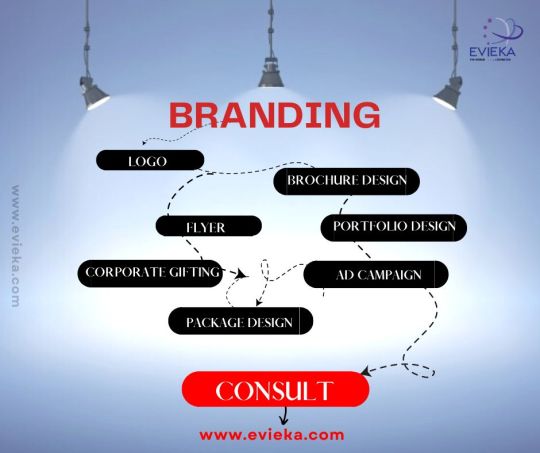#brandcompany
Text

Launch Your Brand! Open Your Company! Whenever You Do, Do It Big! Do With #EVIEKA. We offer you cutting-edge branding services to help businesses stand out and capture the attention to get the target audience.
Stay Turned Us For More Details! https://evieka.com
#Branding #BrandCompany #BusinessBrandingStrategies
#GrowYourBrand #TargetAudience #BrandingServices #BrandAwareness #MarketingGoals
0 notes
Photo

Solution Money Logo You need a logo. 👇👇 Contact me 👇👇 Only 5 - 20$ #vectordesign #vectorillustration #logovector #logoforsales #logoforsale #brandlogos #brandcompany #companyrp #identitydesign #business #businessowner #businessdevelopment #logobusiness #brandbusiness #clothingbrand (di Majalaya, Kab. Bandung Jawa Barat) https://www.instagram.com/p/CSer8bbh3Y8/?utm_medium=tumblr
#vectordesign#vectorillustration#logovector#logoforsales#logoforsale#brandlogos#brandcompany#companyrp#identitydesign#business#businessowner#businessdevelopment#logobusiness#brandbusiness#clothingbrand
0 notes
Photo

#speedart #branddesigner #brandcompany #quik #logodesign #logoMarca #logolove #logopassion #logofreak #logotipos #logousaha #logoplace #logoconcept #logogrid #logoshop #logos #logosdaily #logotype #logosinspire #logoshift #eventplanner #eventdecor #osundesigner #enterpreneur #cx (at Osun Capital) https://www.instagram.com/p/B1lMEu3pCYx/?igshid=i2scktp11ep1
#speedart#branddesigner#brandcompany#quik#logodesign#logomarca#logolove#logopassion#logofreak#logotipos#logousaha#logoplace#logoconcept#logogrid#logoshop#logos#logosdaily#logotype#logosinspire#logoshift#eventplanner#eventdecor#osundesigner#enterpreneur#cx
0 notes
Video
Reposted from @hunnidgrandpromotions @omni.one @hlsfiggaz ITS JUST THE BEGINNING 🚨🔥🔥🚨 #WIN. #Omni #hls🎒 #pasadena #music #hiphop #branding @omni.bags #photooftheday #capitalize #businessowner #brandcompany @hunnidgrandpromotions - #regrann https://www.instagram.com/p/B8shnVspeI4/?igshid=wilpjij1m3ms
#win#omni#hls🎒#pasadena#music#hiphop#branding#photooftheday#capitalize#businessowner#brandcompany#regrann
0 notes
Photo

Looking For Branding for your Company, We provide high-quality design service for your business.
We create a highly advanced & user friendly visual Branding for your brand to make your presence online & offline. Call us on : +91-8698755048, +91-9105152310 or email us at : [email protected] #design #graphic #graphicdesign #designingcompany #web #websitedesign #webdevelopment #development #brand #brandcompany #company #services #bestservices #itservices #piece #dehradun #india
1 note
·
View note
Photo

Spade films ♠ + 🎥 . Available for commission works hit me on DM /email : [email protected] . You can ask anything about design materials. Link in bio . #graphicdesign #logo #logodesigner #logoinspirations #logos #logoideas #logoconcept #minimalism #minimalist #logomania #logoshift #minimallogo #logoawesome #branding #customlogo #customlogodesign #logoprofessionals #logoworld #business #entertainment #brandidentity #movie #movies #films #businesscard #cinema #hollywood #brandcompany #filmproduction #filmfestival (di Los Angeles/Hollywood California) https://www.instagram.com/p/CEmCEetgjf8/?igshid=dwbwlyqw6gcu
#graphicdesign#logo#logodesigner#logoinspirations#logos#logoideas#logoconcept#minimalism#minimalist#logomania#logoshift#minimallogo#logoawesome#branding#customlogo#customlogodesign#logoprofessionals#logoworld#business#entertainment#brandidentity#movie#movies#films#businesscard#cinema#hollywood#brandcompany#filmproduction#filmfestival
0 notes
Text
C-Level Brand Licensing Considerations
This is one of our favorite topics with board members, specifically when it comes to licensing the corporate brand—or not. Ultimately, it doesn’t truly matter whether a brand considers licensing; simply assessing your options gets you into a thorough discussion of the true value of branding and brand management. At the end of the day, your brand is your organization’s most important intellectual asset, and it deserves to be treated as such.
Too often, we notice that many marketing, brand, or communication directors don’t fully understand the relationship between the value of the brand as an asset and the investment level it requires. CFOs do grasp the concept, and this is the time to initiate a discussion with their directors. CFOs should emphasize that the brand needs to be treated as a strategic investment like any other asset, and that investments need to be maintained over time, at a cost.
Exploring The Concept
Before we go into more detail on the subject of brand licensing, let’s explore the concept further. The idea of licensing is that you give someone else (the licensee) the right to use your brand (you’re the licensor) for a certain value, expressed as a percentage of turnover or revenue (the royalty). The simplest example is that you can buy a black cap without a logo for $1.95. Whereas the same cap with a Nike swoosh stitched on it sells for $14.95. Hence, you can imagine that having the intellectual property rights to apply this swoosh has a value of somewhere between $0 and $13.95.
So, How Does it Work?
The licensee would never want to pay the whole difference, as he then wouldn’t be able to generate any margin. Hence the exercise would be pointless. In the business world, this implies that there’s a market for how much royalty one would pay for brands. Obviously, the royalty will vary mostly based on two parameters:
The sector: luxury goods will command a higher royalty than commodity goods
The strength of a brand in a sector: strong brands—stronger then their peers—will command a higher royalty range
We will not elaborate further on exactly what it is that gets licensed in legal terms. For now we’ll assume it’s the trademark and associated rights that go with it.
The Relevance Of Licensing For Corporate Brands
Similar to how licensing works for brands externally, many international organizations own the brand at a group level, or within a Brandcompany (a separate legal entity that owns the intellectual property rights of the corporate brand or organization). This is done to protect the ownership of the brand where there are transactions within the business, and to ensure that the ownership is secured. In exchange, the Brandcompany charges an internal royalty fee to its operating companies.
Apart from the legal ownership and protection-perspective, this construct offers great opportunities for setting up a decent infrastructure and the governance for managing the brand across an organization. The simple fact is that the operating companies pay a charge which comes with a license or royalty agreement, and within this agreement, the rights and obligations for its use are specified. With this agreement in place, the management of the brand is more strongly governed.
As you can imagine and might know from your own experience, there are many internal discussions about how to manage and use a brand within organizations. We recommend to always check the applicability of a potential Brandcompany construct with the internal tax department, as the international framework of tax rulings sometimes enables synergies in this area. Different to many strategic synergies and benefits, the tax synergies are cash-advantages for organizations when applicable after thorough analysis.
Contributed to Branding Strategy Insider by: Marc Cloosterman, CEO, VIM Group. Excerpted and adapted from his book Future Proof Your Brand.
The Blake Project Can Help: We offer brand licensing workshops to help brand owners develop a strategy for licensing or refine an existing one. Another way we serve our clients is through a Brand Licensing Audit which is an essential guide in considering, building and/or fine tuning a program. Please email us for more.
Branding Strategy Insider is a service of The Blake Project: A strategic brand consultancy specializing in Brand Research, Brand Strategy, Brand Licensing and Brand Education
FREE Publications And Resources For Marketers
0 notes
Text

EVIEKA is the most trusted Branding & Brand Positioning company for your business branding. Your Business Awareness will Increase With Our One-Box Marketing Solution.
Stay Turned Us For More Details! https://evieka.com
#Branding #BrandCompany #BusinessBrandingStrategies #Evieka #EviekaMarcomm
0 notes
Photo

✨💜✨💜✨Sweatshirt of character #ellesdtiys . 👉👉👉Art Shop in Bio💫✨✨ Available "Flowers Lady" . ✨✨✨✨✨ . Illustrated by Liz Yelud Adra Order now for: [email protected] . ✨💜✨💜✨Mi version del personaje #ellesdtiys . 👉👉👉Art Shop en la Bio💫✨✨ Disponible "Flowers Lady" ✨✨✨✨✨ . Ilustrado por Liz Yelud Adra Solicitudes por: [email protected] . . . . . . . . . . . . . . #tshirtdesigns #sweater #sweatertshirt #clothesforsale #clothes #branding #brands #goodvibesonly #artdirector #creativedirector #illustratoroninstagram #creativewomen #latinamakersmarket #brandcompany #artfairnyc #womenbusiness #powerfulgirls #portraitillustrations #marketplace #characterconcept #fiverrgigs #fashionstyles2you #fashionista #illustrationartists #illo #artfairs #drawthisinyourstylechallenge https://www.instagram.com/p/CQUA3TiB74H/?utm_medium=tumblr
#ellesdtiys#tshirtdesigns#sweater#sweatertshirt#clothesforsale#clothes#branding#brands#goodvibesonly#artdirector#creativedirector#illustratoroninstagram#creativewomen#latinamakersmarket#brandcompany#artfairnyc#womenbusiness#powerfulgirls#portraitillustrations#marketplace#characterconcept#fiverrgigs#fashionstyles2you#fashionista#illustrationartists#illo#artfairs#drawthisinyourstylechallenge
0 notes
Text
C-Level Brand Licensing Considerations
This is one of our favorite topics with board members, specifically when it comes to licensing the corporate brand—or not. Ultimately, it doesn’t truly matter whether a brand considers licensing; simply assessing your options gets you into a thorough discussion of the true value of branding and brand management. At the end of the day, your brand is your organization’s most important intellectual asset, and it deserves to be treated as such.
Too often, we notice that many marketing, brand, or communication directors don’t fully understand the relationship between the value of the brand as an asset and the investment level it requires. CFOs do grasp the concept, and this is the time to initiate a discussion with their directors. CFOs should emphasize that the brand needs to be treated as a strategic investment like any other asset, and that investments need to be maintained over time, at a cost.
Exploring The Concept
Before we go into more detail on the subject of brand licensing, let’s explore the concept further. The idea of licensing is that you give someone else (the licensee) the right to use your brand (you’re the licensor) for a certain value, expressed as a percentage of turnover or revenue (the royalty). The simplest example is that you can buy a black cap without a logo for $1.95. Whereas the same cap with a Nike swoosh stitched on it sells for $14.95. Hence, you can imagine that having the intellectual property rights to apply this swoosh has a value of somewhere between $0 and $13.95.
So, How Does it Work?
The licensee would never want to pay the whole difference, as he then wouldn’t be able to generate any margin. Hence the exercise would be pointless. In the business world, this implies that there’s a market for how much royalty one would pay for brands. Obviously, the royalty will vary mostly based on two parameters:
The sector: luxury goods will command a higher royalty than commodity goods
The strength of a brand in a sector: strong brands—stronger then their peers—will command a higher royalty range
We will not elaborate further on exactly what it is that gets licensed in legal terms. For now we’ll assume it’s the trademark and associated rights that go with it.
The Relevance Of Licensing For Corporate Brands
Similar to how licensing works for brands externally, many international organizations own the brand at a group level, or within a Brandcompany (a separate legal entity that owns the intellectual property rights of the corporate brand or organization). This is done to protect the ownership of the brand where there are transactions within the business, and to ensure that the ownership is secured. In exchange, the Brandcompany charges an internal royalty fee to its operating companies.
Apart from the legal ownership and protection-perspective, this construct offers great opportunities for setting up a decent infrastructure and the governance for managing the brand across an organization. The simple fact is that the operating companies pay a charge which comes with a license or royalty agreement, and within this agreement, the rights and obligations for its use are specified. With this agreement in place, the management of the brand is more strongly governed.
As you can imagine and might know from your own experience, there are many internal discussions about how to manage and use a brand within organizations. We recommend to always check the applicability of a potential Brandcompany construct with the internal tax department, as the international framework of tax rulings sometimes enables synergies in this area. Different to many strategic synergies and benefits, the tax synergies are cash-advantages for organizations when applicable after thorough analysis.
Contributed to Branding Strategy Insider by: Marc Cloosterman, CEO, VIM Group. Excerpted and adapted from his book Future Proof Your Brand.
The Blake Project Can Help: We offer brand licensing workshops to help brand owners develop a strategy for licensing or refine an existing one. Another way we serve our clients is through a Brand Licensing Audit which is an essential guide in considering, building and/or fine tuning a program. Please email us for more.
Branding Strategy Insider is a service of The Blake Project: A strategic brand consultancy specializing in Brand Research, Brand Strategy, Brand Licensing and Brand Education
FREE Publications And Resources For Marketers
from WordPress https://glenmenlow.wordpress.com/2018/07/18/c-level-brand-licensing-considerations/
via IFTTT
0 notes
Photo

KITA INDONESIA Saling menghormati, penuh toleransi, saling membantu, bermain bersama, berpetualang bersama. Begitulah yang kita rasakan bagaimana Indonesia Waktu kecil rasa itu terlalu kaya kita alami. So marilah menjaganya. Ada lagi yang perlu di tambahkan? #logo #logodesigner #design #designer #bird #phoenix #goldenratio #circleratio #balance #conceptor #consultant #brandcompany #papua #irianjaya #jayapura #indonesia #kitaindonesia #binekatunggalika #norasism #satubangsa #illustratorsoninstagram #illustration #illustrationartists #illustrator #adobeillustrator https://www.instagram.com/p/CMcXm-UBCl3/?igshid=6zkma10v403i
#logo#logodesigner#design#designer#bird#phoenix#goldenratio#circleratio#balance#conceptor#consultant#brandcompany#papua#irianjaya#jayapura#indonesia#kitaindonesia#binekatunggalika#norasism#satubangsa#illustratorsoninstagram#illustration#illustrationartists#illustrator#adobeillustrator
0 notes
Photo

Logo design for CouturebyMoonie. Do you need a Logo? Dm 📩 @cx_movers Follow @cx_movers . . . . . . . . . . #cx #brandingcompany #designer #designlikeapro #marketing #business #brandcompany #company #fast #logo #process #image #coreaspect #company #startup #largescale #smallscale #mediumscale #public #pslicensed #illustration #logodesign #logoMarca #logolove #logopassion #logofreak #logotipos #logousaha #designinspiration #naijadesigners #logoprofessional #logodesign #digital #art #splitjob #split #aspiration #ae #ai #ps #corporateidentity #fashion #fashionsense #couture #clothingbrand #idea #couturebymoonie (at Osogbo) https://www.instagram.com/p/ByIvgxYpOdq/?igshid=5x6unvbsz4w
#cx#brandingcompany#designer#designlikeapro#marketing#business#brandcompany#company#fast#logo#process#image#coreaspect#startup#largescale#smallscale#mediumscale#public#pslicensed#illustration#logodesign#logomarca#logolove#logopassion#logofreak#logotipos#logousaha#designinspiration#naijadesigners#logoprofessional
0 notes
Text
C-Level Brand Licensing Considerations
This is one of our favorite topics with board members, specifically when it comes to licensing the corporate brand—or not. Ultimately, it doesn’t truly matter whether a brand considers licensing; simply assessing your options gets you into a thorough discussion of the true value of branding and brand management. At the end of the day, your brand is your organization’s most important intellectual asset, and it deserves to be treated as such.
Too often, we notice that many marketing, brand, or communication directors don’t fully understand the relationship between the value of the brand as an asset and the investment level it requires. CFOs do grasp the concept, and this is the time to initiate a discussion with their directors. CFOs should emphasize that the brand needs to be treated as a strategic investment like any other asset, and that investments need to be maintained over time, at a cost.
Exploring The Concept
Before we go into more detail on the subject of brand licensing, let’s explore the concept further. The idea of licensing is that you give someone else (the licensee) the right to use your brand (you’re the licensor) for a certain value, expressed as a percentage of turnover or revenue (the royalty). The simplest example is that you can buy a black cap without a logo for $1.95. Whereas the same cap with a Nike swoosh stitched on it sells for $14.95. Hence, you can imagine that having the intellectual property rights to apply this swoosh has a value of somewhere between $0 and $13.95.
So, How Does it Work?
The licensee would never want to pay the whole difference, as he then wouldn’t be able to generate any margin. Hence the exercise would be pointless. In the business world, this implies that there’s a market for how much royalty one would pay for brands. Obviously, the royalty will vary mostly based on two parameters:
The sector: luxury goods will command a higher royalty than commodity goods
The strength of a brand in a sector: strong brands—stronger then their peers—will command a higher royalty range
We will not elaborate further on exactly what it is that gets licensed in legal terms. For now we’ll assume it’s the trademark and associated rights that go with it.
The Relevance Of Licensing For Corporate Brands
Similar to how licensing works for brands externally, many international organizations own the brand at a group level, or within a Brandcompany (a separate legal entity that owns the intellectual property rights of the corporate brand or organization). This is done to protect the ownership of the brand where there are transactions within the business, and to ensure that the ownership is secured. In exchange, the Brandcompany charges an internal royalty fee to its operating companies.
Apart from the legal ownership and protection-perspective, this construct offers great opportunities for setting up a decent infrastructure and the governance for managing the brand across an organization. The simple fact is that the operating companies pay a charge which comes with a license or royalty agreement, and within this agreement, the rights and obligations for its use are specified. With this agreement in place, the management of the brand is more strongly governed.
As you can imagine and might know from your own experience, there are many internal discussions about how to manage and use a brand within organizations. We recommend to always check the applicability of a potential Brandcompany construct with the internal tax department, as the international framework of tax rulings sometimes enables synergies in this area. Different to many strategic synergies and benefits, the tax synergies are cash-advantages for organizations when applicable after thorough analysis.
Contributed to Branding Strategy Insider by: Marc Cloosterman, CEO, VIM Group. Excerpted and adapted from his book Future Proof Your Brand.
The Blake Project Can Help: We offer brand licensing workshops to help brand owners develop a strategy for licensing or refine an existing one. Another way we serve our clients is through a Brand Licensing Audit which is an essential guide in considering, building and/or fine tuning a program. Please email us for more.
Branding Strategy Insider is a service of The Blake Project: A strategic brand consultancy specializing in Brand Research, Brand Strategy, Brand Licensing and Brand Education
FREE Publications And Resources For Marketers
0 notes
Text
C-Level Brand Licensing Considerations
This is one of our favorite topics with board members, specifically when it comes to licensing the corporate brand—or not. Ultimately, it doesn’t truly matter whether a brand considers licensing; simply assessing your options gets you into a thorough discussion of the true value of branding and brand management. At the end of the day, your brand is your organization’s most important intellectual asset, and it deserves to be treated as such.
Too often, we notice that many marketing, brand, or communication directors don’t fully understand the relationship between the value of the brand as an asset and the investment level it requires. CFOs do grasp the concept, and this is the time to initiate a discussion with their directors. CFOs should emphasize that the brand needs to be treated as a strategic investment like any other asset, and that investments need to be maintained over time, at a cost.
Exploring The Concept
Before we go into more detail on the subject of brand licensing, let’s explore the concept further. The idea of licensing is that you give someone else (the licensee) the right to use your brand (you’re the licensor) for a certain value, expressed as a percentage of turnover or revenue (the royalty). The simplest example is that you can buy a black cap without a logo for $1.95. Whereas the same cap with a Nike swoosh stitched on it sells for $14.95. Hence, you can imagine that having the intellectual property rights to apply this swoosh has a value of somewhere between $0 and $13.95.
So, How Does it Work?
The licensee would never want to pay the whole difference, as he then wouldn’t be able to generate any margin. Hence the exercise would be pointless. In the business world, this implies that there’s a market for how much royalty one would pay for brands. Obviously, the royalty will vary mostly based on two parameters:
The sector: luxury goods will command a higher royalty than commodity goods
The strength of a brand in a sector: strong brands—stronger then their peers—will command a higher royalty range
We will not elaborate further on exactly what it is that gets licensed in legal terms. For now we’ll assume it’s the trademark and associated rights that go with it.
The Relevance Of Licensing For Corporate Brands
Similar to how licensing works for brands externally, many international organizations own the brand at a group level, or within a Brandcompany (a separate legal entity that owns the intellectual property rights of the corporate brand or organization). This is done to protect the ownership of the brand where there are transactions within the business, and to ensure that the ownership is secured. In exchange, the Brandcompany charges an internal royalty fee to its operating companies.
Apart from the legal ownership and protection-perspective, this construct offers great opportunities for setting up a decent infrastructure and the governance for managing the brand across an organization. The simple fact is that the operating companies pay a charge which comes with a license or royalty agreement, and within this agreement, the rights and obligations for its use are specified. With this agreement in place, the management of the brand is more strongly governed.
As you can imagine and might know from your own experience, there are many internal discussions about how to manage and use a brand within organizations. We recommend to always check the applicability of a potential Brandcompany construct with the internal tax department, as the international framework of tax rulings sometimes enables synergies in this area. Different to many strategic synergies and benefits, the tax synergies are cash-advantages for organizations when applicable after thorough analysis.
Contributed to Branding Strategy Insider by: Marc Cloosterman, CEO, VIM Group. Excerpted and adapted from his book Future Proof Your Brand.
The Blake Project Can Help: We offer brand licensing workshops to help brand owners develop a strategy for licensing or refine an existing one. Another way we serve our clients is through a Brand Licensing Audit which is an essential guide in considering, building and/or fine tuning a program. Please email us for more.
Branding Strategy Insider is a service of The Blake Project: A strategic brand consultancy specializing in Brand Research, Brand Strategy, Brand Licensing and Brand Education
FREE Publications And Resources For Marketers
0 notes
Photo

BILA SAMA APA BEDANYA? selamat bersyukur di hari minggu, hindari mengambil hak sesamamu. #brand #branding #brandcompany #branddesign #umkm #stronger #designer #design #consultant #conceptor #covid_19 #pandemic #pandemicefect #freelancer #freelance #freelancerindonesia #influencer #influencers #logodesigner #logoconcept #logo #designerfashion #fashionblogger #vlogger #musician #music #videoeditor #designgraphic #quote https://www.instagram.com/p/CMYsIOiBB0q/?igshid=1oi76k43fimv2
#brand#branding#brandcompany#branddesign#umkm#stronger#designer#design#consultant#conceptor#covid_19#pandemic#pandemicefect#freelancer#freelance#freelancerindonesia#influencer#influencers#logodesigner#logoconcept#logo#designerfashion#fashionblogger#vlogger#musician#music#videoeditor#designgraphic#quote
0 notes
Photo

The City Of Land Eight Logo Original logo by HiBudyantoLalu © Copyright 2020 HiBudyantoLalu https://www.logoground.com/logo.php?id=420377 #logoground #logodesigner #logoconcept #logo #designer #design #eight #8 #city #branding #brandcompany #brand #image #blue #consultant https://www.instagram.com/p/CMMG-_3gWxt/?igshid=1lqy00jliyyp3
#logoground#logodesigner#logoconcept#logo#designer#design#eight#8#city#branding#brandcompany#brand#image#blue#consultant
0 notes